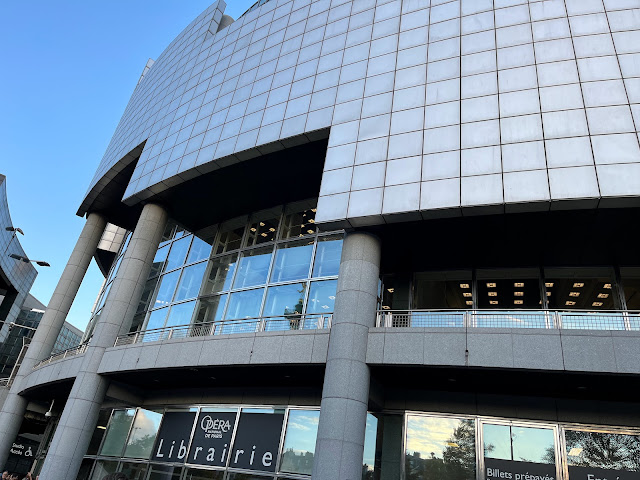The Opera
Boston has world-class cultural offerings, but is not much of an opera city. Indianapolis, also, punches above its weight culturally (quite good symphony, excellent art museum), but opera is nonexistent. So, I have lived most of my life in cities where the operatic offerings are few and far between.
My first taste of opera was a trip to Cincinnati with a friend and her family to see Atilla by Verdi. I was probably in seventh or eighth grade. I remember my friend Susan giving me some tips about how to make the time go a bit faster--counting ceiling tiles, silently naming brands of cigarettes--but I don't think I needed them in the end. I was well-acquainted with both musical theater and symphonic music at that point, and opera seemed like an interesting hybrid of the two. The time passed pretty quickly. And, of course, we got dressed up and went to a fancy restaurant, which made it more fun.
But that was it for opera for many years.
When we lived in Paris before, I was not focused on purchasing tickets to the opera initially. It only occurred to me after we had been there for a few months, and we ended up getting tickets to two or three shows, and the seats were far from ideal. Still, my long-dormant interest in opera was rekindled, so I vowed to be more intentional this time, buying season tickets in advance (and choosing better seats).
We have been to two operas so far this year. The first was with an MIT friend, Susan, who was here with her daughter and also visiting colleagues at Sciences Po. We saw Mozart's Don Giovanni at the Opera Bastille (Paris' modern opera house, pictured below). As always, the performances were fantastic, but the production was a bit unusual. It had light comic elements throughout, so I was wondering how they would handle the very heavy final scene where the womanizing, narcissistic main character is dragged down to hell. And, in fact, it was very heavy, which seemed a little incongruous.
The whole opera was set in a forest constructed on stage where part of the forest was on a large turntable. As the turntable rotated, parts of the forest became denser or opened up, as the moving and stationary trees interacted in interesting ways. I spent a lot of the time wondering how the precise placement of the trees was arrived at, and how the movement of the turntable was determined, and how those decisions must have been made in close consultation with the people working on specific stage directions for the performers. In short, I was struck by the complicated and detailed work that must have gone on behind the scenes.
The second opera we saw was Don Pasquale by Donizetti. This one was at the famous Palais Garnier, Paris' opulent 19th Century opera house. It was a fun, light-hearted, buoyant production with some interesting video elements. At certain points, some of the characters visited a studio for some reason that I can't remember, and live video of them was shown on a large screen simultaneously. I thought the device was used pretty effectively to show the audience much greater detail in those moments.
Here is our view of the stage from our seats in a private box. Although the seats were far from the most expensive available, I thought they were quite good.
This production was set in some undetermined modern time and place, if I recall, but I have noticed a strange regularity across many productions of operas that I have seen or heard about. I love that so many modern stagings of Italian operas are set in the 1950s and 60s. I'm not sure why that is. One theory is that it's fun and relatively easy to get tiny vintage Fiats on the stage. I believe that a previous production of Don Pasquale by the Paris Opera had a tiny vintage Fiat on the stage.
Our third opera of the year was to be last night, Cendrillon at the Bastille. In an unmistakably French plot twist, I received this email yesterday:
There will be others...





Comments
Post a Comment